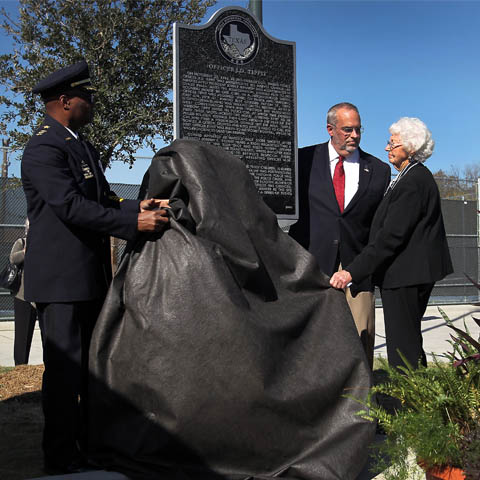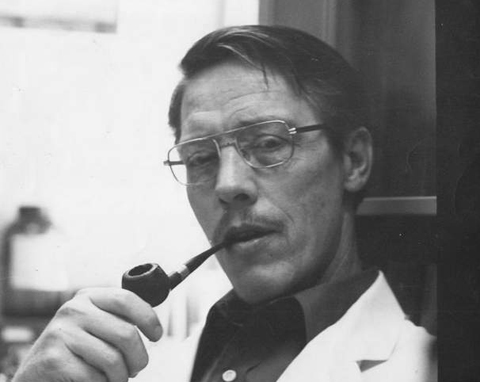by AVI SELK / Dallas Morning News
Despite half a century of renovations, a boxy little tract house on West Fifth Street has never been able to leave its past behind.
New owners have come and gone: changed the windows, painted the bricks, built new walls. But the tourists who still gawk daily from the sidewalk will always see Ruth Paine’s house on Nov. 22, 1963 — the morning her houseguest fetched his rifle from the garage and headed into Dallas, where the president would be killed soon after.
So the house’s latest owner is embracing its past: scraping off paint, tearing down walls and replacing the fake hardwood of later eras with kitchen tile like that in Paine’s old family photos.
The city of Irving wants to restore nearly every detail of what is set to become the Paine House Museum next fall, just in time for the 50th anniversary of a suburban mother’s last encounter with Lee Harvey Oswald.
Different angle
“The story of the assassination has been told and told,” said Kevin Kendro, the city archivist heading up the project. “We want to focus on Ruth Paine — this Irving housewife living out here in the suburbs.”
The city hopes visitors will pay to walk on Paine’s restored kitchen floor, past a replica of her old telephone stand, and learn how her kindness to Oswald’s family earned her a footnote in his infamy.
Now in her 80s, living in a Quaker community in California, Paine sounds touched — if a touch puzzled — by the project.
“I’d perhaps heard that people drove by,” she said. “But I wasn’t aware there was that much interest in it.”
Paine traded the little house off Story Road for a bigger one a few years after the assassination — after the swarms of FBI agents and newsmen had stopped knocking, but long before the tourists began to trickle past.
“Nobody comes by the other house, do they?” she chuckled. “I think I’m not the one they’re interested in.”
Meeting Marina
With two small children and separated from her husband, Paine met Marina Oswald at a party several months before the assassination, bonding with the Russian immigrant despite a language barrier.
When Marina’s husband lost his job, Paine offered her and her baby a room while Lee Oswald looked for work in other cities. She was happy for the company.
Oswald would usually visit on the weekends — a polite houseguest, Paine said, though somewhat overbearing toward Marina.
The couple had an argument by phone the week before the assassination, after Marina learned her husband had been using a fake name on his supposed job hunts.
“That was one of the first clues I had that he wasn’t tucked together well,” Paine recalled.
When Oswald showed up without warning that Thursday, Paine was surprised: He never visited Marina on weekdays or unannounced. She thought perhaps he was there to apologize.
Now she knows better. The next morning, her guest rose quietly in the spare bedroom, left his wedding ring on the dresser and slipped into the cluttered garage.
There, wrapped in a blanket atop a pile of his family’s belongings, lay the rifle Oswald had kept secret from his host.
Reconstructing
Today, the garage is filled with paint buckets, planks, a dismantled sink, closet doors and other post-Paine renovations the city has been tearing out all year.
Replacing them is the tricky part.
Paine moved out of the house after the assassination to pursue a career in education — setting up one of Irving’s first integrated schools before leaving Texas. The only artifacts she’s kept from her old house are a set of hi-fi speakers and a lamp she’s still trying to find for the city.
So Kendro is trying to re-create the Paine House from a smattering of family photos, magazine articles, government reports, and Paine’s imperfect memories.
The archivist is being as meticulous as he can.
City maintenance workers carefully reconstructed a two-foot section of Paine’s knotted-pine cabinet that had been cut away to accommodate a dishwasher.
Crews used Paine’s recollections and faded outlines in the paint to reconstruct her telephone stand. They turned a non-historic third bedroom back into Paine’s dining room and rebuilt the picture window that once looked over the Oswalds’ double bed and baby crib.
But other details are lost to history. Paine simply can’t remember what her kitchen countertop looked like. And while Kendro managed to find an exact copy of her garage door, he couldn’t do the same for her screen.
For all these limits, Kendro has made only one concession to modernity: Visitors to Paine’s old house will enjoy the air conditioning she and the Oswalds had lacked.
Satisfying curiosity
Besides $175,000 to buy the house three years ago, Irving has so far spent about $30,000 restoring it. Officials say the city has up to $100,000 to finish the job: decorate the interior, build a visitors center and hire a company to construct exhibits.
The museum will sit in the middle of a residential neighborhood, its authentic 1960s driveway barely able to accommodate an SUV. So Kendro plans to bus tour groups in from an off-site visitors center.
That’s a relief to neighbors on the car-lined street, whose chief thoughts about the project centered on its traffic impact.
Kendro doesn’t know if the museum will be popular, or how many who snap pictures from the sidewalk will pay to step inside.
Paine has no plans to be among them, unless the city needs her to help promote the museum.
“Let the people who are interested go look,” she said.
The archivist takes a more holistic view.
“Ruth just sees it as a place he stayed; it doesn’t have any effect on the big story,” said Kendro. “And she’s correct in that regard. But, you know, humans are curious.
“It’s just another aspect to this humongous historic event,” he said. “And it sent a ripple into this one little life, changing it forever.”






